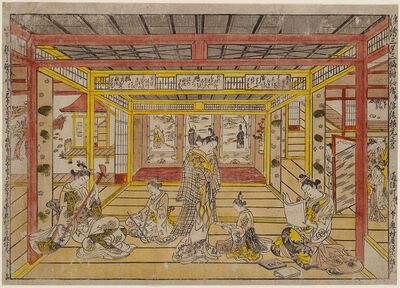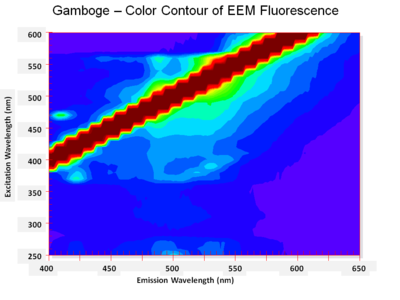Gamboge: Ukiyo-e colorant
Gamboge 藤黄 (tōō): A yellow-orange gum resin produced by several species of the Garcinia tree, such as Garcinia morella found in South Asia and Garcinia hanburyi found in Southeast Asia. Gamboge is composed of a yellow resinous component (70-80%; morelloflavone) and a clear water-soluble Gum (20%). It was collected in South Asia by cutting a large piece off the trunk. The exuding sap from the exposed wood was scraped off and dried. In Southeast Asia, most notably Thailand, gamboge was obtained by scoring the trunk and collecting the sap in bamboo canes. Once the sap solidified, the bamboo was roasted over a fire during which the bamboo cracked or evaporated the moisture in the gamboge to become detached from the bamboo to reveal a cylindrical shaped gamboge. Crushed into powder, it becomes a bright yellow. Gamboge was used as a yellow pigment as early as the 8th century in Asia and Japan. During the Edo period (1603–1868), gamboge was known to be imported from Siam (Thailand) and Cochin (Vietnam but could also be Kochi, India).
Gamboge produces a transparent yellow which was frequently hand-painted on prints dating from the 1690s to the 1740s. After the introduction of full color printing, its use seems to decline perhaps because the other yellows were easier to obtain and/or print and mix with other colorants.
For additional information see: Gamboge, Uemura Dye Archive: Gamboge 195, Garcinia hanburyi (Kew), Garcinia morella (Kew)
Examples of Gamboge in Ukiyo-e Prints

|

|

|

|

|
Analysis
Gamboge does not fluoresce under UVA radiation and does not produce a distinct pattern using Excitation Emission Matrix (EEM) spectroscopy. This, in itself is unique because of the possible yellow colorants analyzed, it is the only bright yellow colorant that not only does not fluoresce but also absorbs the fluorescence emitted by the paper. This negative indication can be sometimes used to assign the presence of gamboge.
Images of Gamboge
List of Prints
Below is a list of prints where gamboge was detected.
Pages in category "Gamboge: Ukiyo-e colorant"
The following 12 pages are in this category, out of 12 total.
G
K
- Kiyomasu I, Courtesan Reading a Poem, 28.198
- Kiyomasu II, Actor Ogino Izaburô I as Yamagami Gennai, Acting in the Aragoto Style with the Sumikazura Wig, 11.13297
- Kiyomasu II, Actors Segawa Kikunojô I as Yomogiu, Ichikawa Ebizô II as Tono no Hyôe, and Yamamoto Kyôzô as Kureha, 21.5459
- Komatsuken, Courtesan Parading with Two Kamuro, 11.19711
- Komatsuken, Young Man as the Bodhisattva Monju, 11.30137
- Komatsuken, Young Woman as the Bodhisattva Fugen, 11.30136










